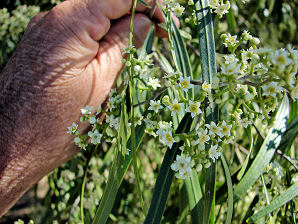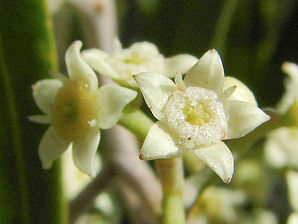Non - Xeriscape.
Common Landscape Plants. Shrubs, Flowers, & Trees.
For The Arizona Desert Environment
Pictures, Photos, Images,
Descriptions, & Reviews.
California Pepper Tree, Schinus molle.
We Are Proud Of Our SafeSurf Rating!
Click On Any Of The Following Links By Amazon.Com
To View Tools For Desert or Arizona Gardening. No Obligation!
 |
| California Pepper Tree, Schinus molle. Arrowhead Ranch, Glendale, Arizona. January 21, 2006. |
|---|
 |  |
| California Pepper Tree, Schinus molle. | California Pepper Tree, Schinus molle. |
|---|---|
 |  |
| California Pepper Tree, Schinus molle. | California Pepper Tree, Schinus molle Leaves. |
California Pepper Tree.
We wish to thank Wikipedia, the free encyclopedia for some of the information on this page. We share images and information with Wikipedia. Brazilian peppertree is a shrubby tree with narrow, spiky leaves. It grows 12 to 36 feet tall, with a trunk 9 to 18 inches in diameter. In the summer it produces an abundance of small flowers formed in panicles that bear a great many small, flesh-colored, berry-like fruits in December and January. It is native to South and Central America and can also be found in the semitropical and tropical regions of the United States and Africa. In both North and South America, there are three different trees - Schinus molle, Schinus aroeira, and Schinus terebinthifolius - all of which are interchangeably called "peppertrees." California Pepper Tree is a small bushy evergreen tree or large shrub with compound leaves and shiny red berrys. They are added to Chilean wines; and are dried and ground up for a pepper substitute in the tropics. It is in the same family as Poison Ivy. Older trees develop characteristically burled trunks and branches. Drought-tolerant; suitable for xeriscaping Be sure to plant California Pepper Tree away from paving, near house foundations, patio paving or entrances, in lawns, or near sewers and drains; because its roots crawl along near the surface and can cause destruction. Their leaves look bright green and healthy even under drought conditions, but what really happens is that while the leaves stay green, their branches may hollow out and when the wind comes the branches snap off.
Quick Notes:
Height: 12 To 36 feet. Spread may reach 40 feet.
Flowers: 6 inch long panicles (clusters) of tiny yellow - white flowers.
Flowering Time: June - August.
Fruit: Pink to red berry like drupes.
Bark: Light brown and rough but becomes furrowed into narrow, firm ridges and darkens with age.
Leaves: Bright Green. Pinnate odd, 3 to 13 leaflets ( usually 7 ), leaves are 5 - 8 inches long, each of the 3 - 13 ( usually 7 ) leaflets are 1 - 2 inches long. Single tip leaflet.
Found: Native Peru. Found in South and Central America, Mexico, Tropical and subtropical parts of the world, including the USA. Found throughout Arizona at lower elevations. The USDA claims it is now native to the USA (CA, FL, HI, TX), USA+ (PR).
Hardiness:
Soil pH requirements:
Sun Exposure:
Elevation: In Arizona usually at 850 to 1,600 feet.
Habitat: Lower elevations where water is available. It grows well in sand, sandy loam, clay and other heavy soils. It needs good drainage and aeration. It is remarkably tolerant of alkali. In its native habitat it is found at the base of "barrancos" where, even during the dry season, a small amount of water is always present in the soil.
Miscellaneous: Flowering Photos Taken at Sun City, Arizona. January 16, 2006.
|
We Are Proud Of Our SafeSurf Rating!
Click On Any Of The Following Links By Amazon.Com
To View Tools For Desert or Arizona Gardening. No Obligation!
| © 1966 - Present, Audrey, Eve, & George DeLange |





